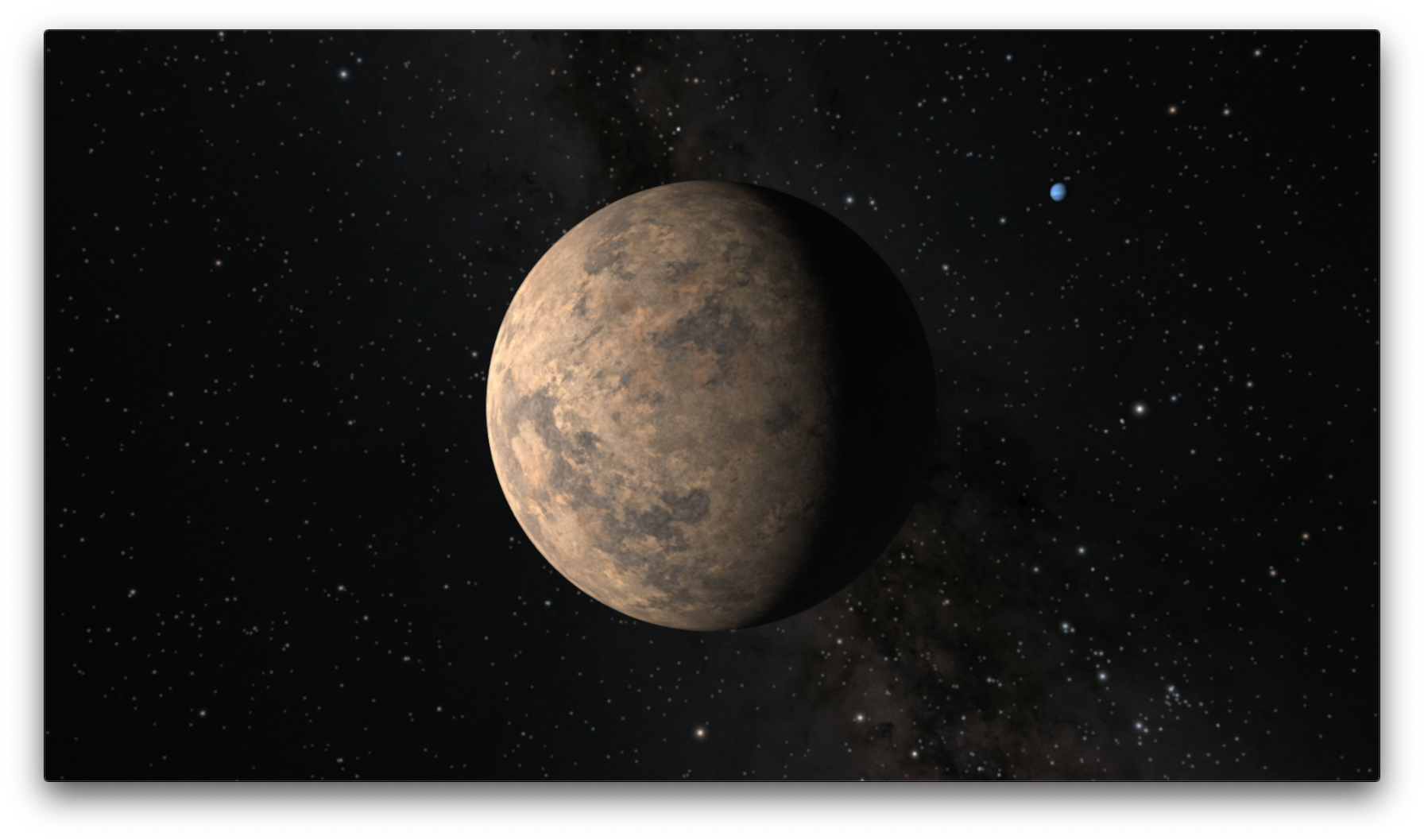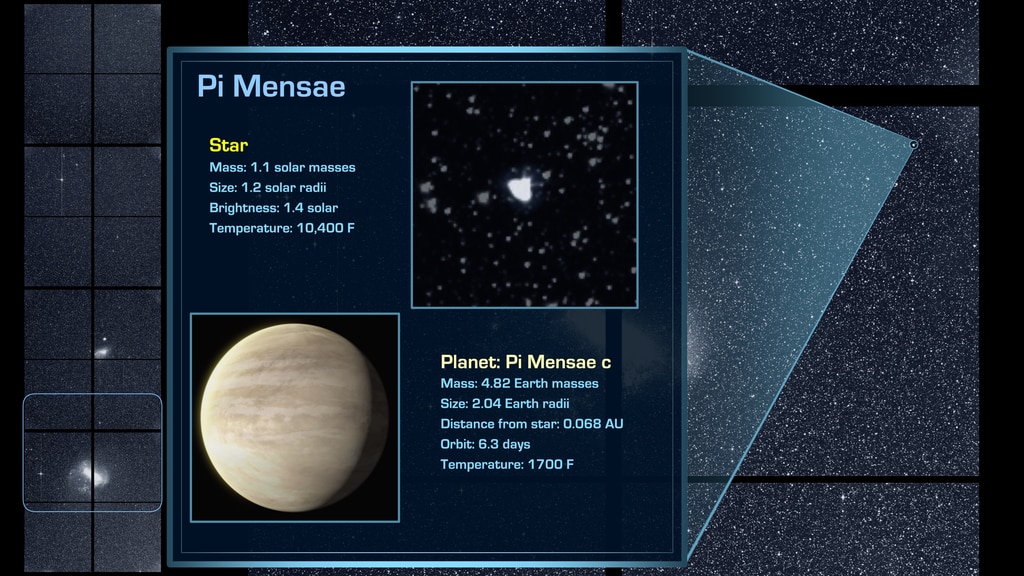NASA’s TESS Releases First Science Image

The Transiting Exoplanet Survey Satellite (TESS) took this snapshot of the Large Magellanic Cloud (right) and the bright star R Doradus (left) with just a single detector of one of its cameras on Tuesday, Aug. 7. The frame is part of a swath of the southern sky TESS captured in its “first light” science image as part of its initial round of data collection.
Credit: NASA/MIT/TESS
NASA’s newest planet hunter, the Transiting Exoplanet Survey Satellite (TESS), is now providing valuable data to help scientists discover and study exciting new exoplanets, or planets beyond our solar system. Part of the data from TESS’s initial science orbit includes a detailed picture of the southern sky taken with all four of the spacecraft’s wide-field cameras. This “first light” science image captures a wealth of stars and other objects, including systems previously known to have exoplanets.
TESS acquired the image using all four cameras during a 30-minute period on Tuesday, Aug. 7. The black lines in the image are gaps between the camera detectors. The small bright dot above the Small Magellanic Cloud is a globular cluster — a spherical collection of hundreds of thousands of stars — called NGC 104, also known as 47 Tucanae because of its location in the southern constellation Tucana, the Toucan. Two stars, Beta Gruis and R Doradus, are so bright they saturate an entire column of pixels on the detectors of TESS’s second and fourth cameras, creating long spikes of light.
TESS’s cameras, designed and built by MIT’s Lincoln Laboratory in Lexington, Massachusetts, and the MIT Kavli Institute, monitor large swaths of the sky to look for transits. Transits occur when a planet passes in front of its star as viewed from the satellite’s perspective, causing a regular dip in the star’s brightness.
TESS will spend two years monitoring 26 such sectors for 27 days each, covering 85 percent of the sky. During its first year of operations, the satellite will study the 13 sectors making up the southern sky. Then TESS will turn to the 13 sectors of the northern sky to carry out a second year-long survey.

The Transiting Exoplanet Survey Satellite (TESS) took this snapshot of the Large Magellanic Cloud (right) and the bright star R Doradus (left) with just a single detector of one of its cameras on Tuesday, Aug. 7. The frame is part of a swath of the southern sky TESS captured in its “first light” science image as part of its initial round of data collection.
Credit: NASA/MIT/TESS

The Transiting Exoplanet Survey Satellite (TESS) captured this strip of stars and galaxies in the southern sky during one 30-minute period on Tuesday, Aug. 7. Created by combining the view from all four of its cameras, this is TESS’s “first light,” from the first observing sector that will be used for identifying planets around other stars. Notable features in this swath of the southern sky include the Large and Small Magellanic Clouds and a globular cluster called NGC 104, also known as 47 Tucanae. The brightest stars in the image, Beta Gruis and R Doradus, saturated an entire column of camera detector pixels on the satellite’s second and fourth cameras. Labeled
Credit: NASA/MIT/TESS

The Transiting Exoplanet Survey Satellite (TESS) captured this strip of stars and galaxies in the southern sky during one 30-minute period on Tuesday, Aug. 7. Created by combining the view from all four of its cameras, this is TESS’ “first light,” from the first observing sector that will be used for identifying planets around other stars. Notable features in this swath of the southern sky include the Large and Small Magellanic Clouds and a globular cluster called NGC 104, also known as 47 Tucanae. The brightest stars in the image, Beta Gruis and R Doradus, saturated an entire column of camera detector pixels on the satellite’s second and fourth cameras. No object labels.
Credit: NASA/MIT/TESS

The Transiting Exoplanet Survey Satellite (TESS) captured this strip of stars and galaxies in the southern sky during one 30-minute period on Tuesday, Aug. 7. Created by combining the view from all four of its cameras, this is TESS’s “first light,” from the first observing sector that will be used for identifying planets around other stars. Notable features in this swath of the southern sky include the Large and Small Magellanic Clouds and a globular cluster called 47 Tucanae. The brightest stars in the image, Beta Gruis and R Doradus, saturated an entire column of camera detector pixels on the satellite’s second and fourth cameras. No Labels.
Credit: NASA/MIT/TESS

The Transiting Exoplanet Survey Satellite (TESS) captured this strip of stars and galaxies in the southern sky during one 30-minute period on Tuesday, Aug. 7. Created by combining the view from all four of its cameras, this is TESS’s “first light,” from the first observing sector that will be used for identifying planets around other stars.
Credit: NASA/MIT/TESS

The Transiting Exoplanet Survey Satellite (TESS) captured this square of stars in the southern sky with its first camera during one 30-minute period on Tuesday, Aug. 7. Bright objects are labeled.
Credit: NASA/MIT/TESS

The Transiting Exoplanet Survey Satellite (TESS) captured this square of stars in the southern sky with its second camera during one 30-minute period on Tuesday, Aug. 7. Bright stars are labeled.
Credit: NASA/MIT/TESS

The Transiting Exoplanet Survey Satellite (TESS) captured this square of stars and galaxies in the southern sky with its third camera during one 30-minute period on Tuesday, Aug. 7. Bright objects are labeled.
Credit: NASA/MIT/TESS

The Transiting Exoplanet Survey Satellite (TESS) captured this square of stars and galaxies in the southern sky with its fourth camera during one 30-minute period on Tuesday, Aug. 7. Bright objects are labeled.
Credit: NASA/MIT/TESS

The Transiting Exoplanet Survey Satellite (TESS) captured this square of stars in the southern sky with its first camera during one 30-minute period on Tuesday, Aug. 7. Unlabeled.
Credit: NASA/MIT/TESS

The Transiting Exoplanet Survey Satellite (TESS) captured this square of stars in the southern sky with its second camera during one 30-minute period on Tuesday, Aug. 7. Unlabeled.
Credit: NASA/MIT/TESS

The Transiting Exoplanet Survey Satellite (TESS) captured this square of stars and galaxies in the southern sky with its third camera during one 30-minute period on Tuesday, Aug. 7. Unlabeled.
Credit: NASA/MIT/TESS

The Transiting Exoplanet Survey Satellite (TESS) captured this square of stars and galaxies in the southern sky with its fourth camera during one 30-minute period on Tuesday, Aug. 7. Unlabeled.
Credit: NASA/MIT/TESS
Credits
Please give credit for this item to:
NASA's Goddard Space Flight Center. However, individual items should be credited as indicated above.
-
Producer
- Scott Wiessinger (USRA)
-
Technical support
- Aaron E. Lepsch (ADNET Systems, Inc.)
-
Science writers
- Jeanette Kazmierczak (University of Maryland College Park)
- Francis Reddy (University of Maryland College Park)
-
Scientist
- Padi Boyd (NASA/GSFC)
-
Visualizer
- Francis Reddy (University of Maryland College Park)
Release date
This page was originally published on Monday, September 17, 2018.
This page was last updated on Sunday, February 16, 2025 at 11:16 PM EST.



